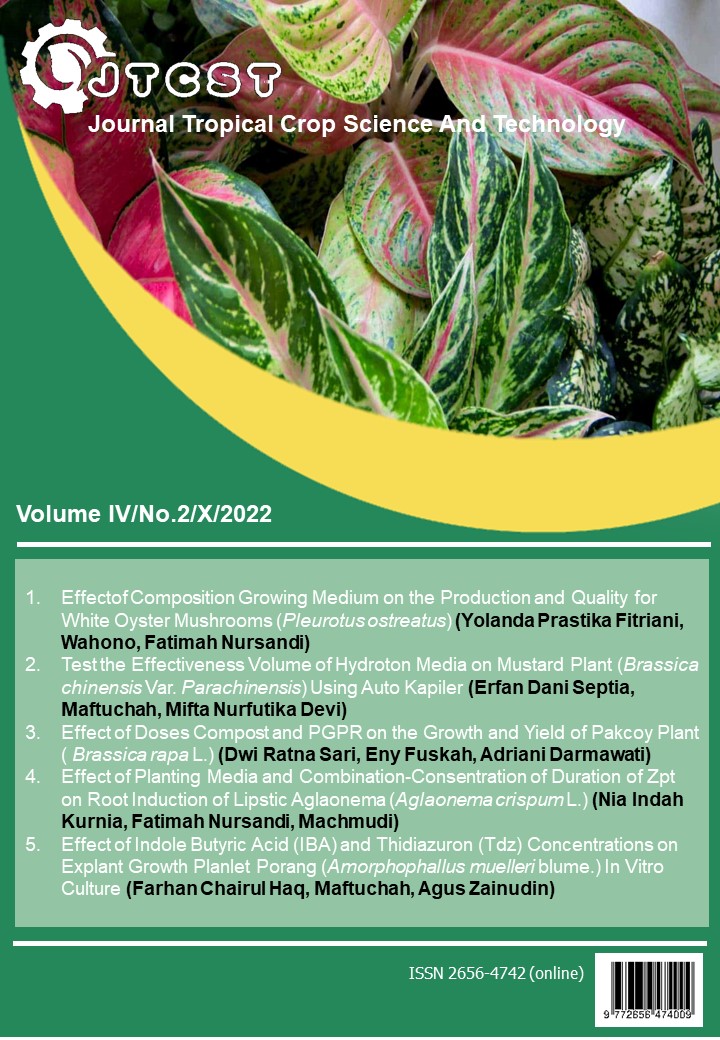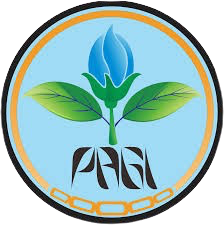Effect of Doses Compost and PGPR on the Growth and Yield of Pakcoy Plants (Brassica rapa L.)
DOI:
https://doi.org/10.22219/jtcst.v4i2.14249Keywords:
Compost, Pakcoy, Growth, PGPRAbstract
Pakcoy is a viable horticultural plant. High consumer demand, but the national pakcoy production is still low. This study aimed to examine the effect of various compost doses and PGPR doses on the growth and yield of pakcoy plants. This study used a 5x4 factorial RAL with 3 replications. The first factor is compost dosage (K) consisting of K0 = 0 kgN/ha compost, K1 = 138 kgN/ha compost, K2 = 69 kgN/ha compost, and K3 = 138 kgN/ha compost, K4 = 207 kgN/ha compost. The second factor is the PGPR dose (P) consisting of P0 = 0 ml/l water, P1 = 5 ml/l water, P2 = 10 ml/l water, and P3 = 15 ml/l water. The results showed that offering compost as much as 207 kgN/ha increased the growth and yield of pakcoy plants compared to giving 138 kgN/ha of inorganic fertilizer. The increase in the PGPR dose that was applied 2 times at planting and 14 days after planting (DAT) of 200 ml did not significantly increase the growth and yield of pakcoy plants.
Downloads
References
Agyeman, K., Afuakwa, J. J., Danquah, E. O., & Asubonteng, K. O. (2012). Improving soil fertility for maize (Zea mays L.) production using inorganic and organic fertilizer: a case of n:p:k 15:15:15 and biomass of agroforestry trees. South Asian Journal of Experimental Biology, 2(1), 5-11.
Arrizqi, Z. R. & Sitawati. (2018). Efisiensi penggunaan pupuk kandang sapi dengan aplikasi plant growth promoting rhizobacteria (pgpr) terhadap pertumbuhan dan hasil tanaman kailan (Brassica oleraceae var. alboglabra). J. Produksi Tanaman, 6(8), 1992-1999.
Bergfeldt, B., Margono, M. T., Leibold, H., Ritcher, F., & Stapf, D. (2018). Recovery of phosphorus and other nutrients during pyrolysis of chicken manure. Agriculture, 8(12), 1-10.
Bustami, Y., Wahyuni, F. R. E., Syafruddin, D., & Mulyono. (2019). Control pests in the fgreen mustard plant through papaya leaf extract. EurAsian Journal of BioSciences, 13(1), 913-919.
Direktorat Jenderal Hortikultura. 2019. Statistik Produksi Sayuran. Internet][diunduh 2020 Juli 29] tersedia pada www.hortikultura.pertanian.go.id.
Fikdalillah, Basir, M., & Wahyudi, I. (2016). Pengaruh pemberian pupuk kandang sapi terhadap serapan fosfor dan hasil tanaman sawi putih (Brassica pekinensis) pada entisol sidera. E. Jurnal Agrotekbis, 4(5), 491-499.
Hijria, Febrianti, E., Anas, A. A., Rustam, L. O., Botek, M., Arsyd, M. A., & Dedu, L. O. A. (2019). Rekayasa mutu tanah pasir pantai melalui aplikasi bahan organik terhadap pertumbuhan dan produksi tanaman sawi (Brassica juncea L.). Jurnal Tabaro, 3(2), 346-353.
Husnihuda, M. I., Sarwitri, R., & Susilowati, Y. E. (2017). Respon pertumbuhan dan hasil kubis bunga (Brassica oleracea var. botrytis, L.) pada pemberian pgpr akar bambu dan komposis media tanam. Jurnal Ilmu Pertanian Tropika dan Subtropika, 2(1), 13-16.
Ikhwan, A., Septia, E. D., & Novita, B. A. (2022, February). Molecular Identification of Potential Rhizobacteria Isolated from Maize (Zea mays L.). In IOP Conference Series: Earth and Environmental Science (Vol. 985, No. 1, p. 012010). IOP Publishing.
Irawati, H., Purbajanti, E. D., Sumarsono, & Fatchullah, D. (2017). Penggunaan macam mulsa dan pola jarak tanam terhadap pertumbuhan dan produksi pakchoy (Brassica rapa chinensis l.). Jurnal Agro Complex, 1(3), 78-84.
Irwanto, Zulia, C., & Purba, D. W.( 2018). Respon pertumbuhan dan produksi tanaman sawi kailan (Brassica oleraceae Var. acephala) terhadap pemberian bokashi eceng gondok dan berbagai jenis urin ternak. Agricultural Research Journal, 14(1), 99-106.
Iswati, R. (2012). Pengaruh dosis formula pgpr asal perakaran bambu terhadap pertumbuhan tanaman tomat (Solanum lycopersicum sym), JATT 1(1), 9-12.
Kurniasih, F. P., & Soedradjad, R. (2019). Pengaruh kompos dan pgpr (plant growth promoting rhizobacteria) pada lahan kering terhadap produksi sawi (Brassica rapa L.). Berkala Ilmiah Pertanian, 2(4), 159-163.
Kurniawati, H., & Very, K. (2019). Peningkatan pertumbuhan dan hasil sawi hijau (Brassica juncea L.) dengan pemberian bokashi eceng gondok (Eichornoa crassipes). Piper, 15(28), 1-11.
Marpaung, A. E. (2017). Pemanfaatan jenis dan dosis pupuk organik cair (poc) untuk meningkatkan pertumbuhan dan hasil sayuran kubis. Jurnal Agroteknosains, 1(2), 117-123.
Nababan, R. S., Gustianty, L. R., & Efendi, E. (2018). Pengaruh aplikasi zpt organik terhadap pertumbuhan dan produksi berbagai varietas sawi hijau (pai-tsai) (Brassica juncea L.). BERNAS Agricultural Research Journal, 14(2), 124-133.
Naihati, Y. T., Taolin R. I. C. O., & Rusae A. (2018). Pengaruh takaran dan frekuensi aplikasi PGPR terhadap pertumbuhan dan hasil tanaman selada (Lactuca sativa L.). J. Pertanian Konservasi Lahan Kering, 3(1), 1-3.
Panggabean, D. P. & Sudiarso. (2019). Pengaruh pemberian pgpr (plant growth promoting rhizobacteri) dan pupuk kandang kambing terhadap pertumbuhan tembakau (Nicotiana tabacum L.). J. Produksi Tanaman, 7(4), 616-620.
Perwitasari, B., Tripatmasari, M., & Wasonowati, C. (2012). Pengaruh media tanam dan nutrisi terhadap pertumbuhan dan hasil tanaman pakchoy (Brassica rapa L.) dengan sistem hidroponik. Jurnal Agrovigor, 5(1), 14-25.
Phat, T. D., Phuong, T. V., & Diep, C. N. (2019). Effect of compost, npk and plant growth promoting rhizobacteria (pgpr) on growth and yield of three vegetables cultivated on arenosols. International Journal of Environmental & Agriculture Research, 5(1), 27-34.
Prasad, R., Singh, J., & Kalamdhad, A. S. (2013). Assesment of nutrients and stability parameters during composting of water hyacinth mixed with cattle manure and sawdust. Research Journal of Chemical Science, 3(4), 70-77.
Purnaman, R. H., Santoso, S. J., & Hardiatmi, S. (2013). Pengaruh dosis pupuk kompos eceng gondok dan jarak tanam terhadap pertumbuhan dan hasil tanaman sawi (Brassica juncea L.). Jurnal Inovasi Pertanian, 12(2), 95-107.
Rosyida & Nugroho, A. S. (2017). Pengaruh dosis pupuk majemuk npk dan plant growth promoting rhizobacteria (pgpr) terhadap bobot basah dan kadar klorofil daun tanaman pakcoy (Brassica rapa L.). Bioma, 6(2), 42-56.
Sakalena, F. (2015). Pengaruh pemberian jenis kompos limbah pertanian dan pupuk organik cair terhadap pertumbuhan dan produksi tanaman sawi (Brassica juncea L.) di polibag. Jurnal Klorofil, 10(2), 82-89.
Simangunsong, S. D., Efendi, E,. & Safruddin. (2018). Kajian pertumbuhan dan produksi tanaman kangkung (Ipomoea repatns Poir) terhadap pemberian berbagai jenis pupuk organik dan pupuk n. BERNAS Agricultual Research Journal, 14(2), 89-100.
Singh, J. & Kalamdhad, A.S. (2015). Assesment of compost quality in agitated pile composting of water hyacinth collected from different sources. International Journal Recycl Org Waste Agricult, 4(1), 175-183.
Sinolungan, M. T. M. & Kumolontang W. N. J. (2017). Aplikasi sedimen danau tondana sebagai media tanam bagi pertumbuhan tanaman pakcoy. Eugenia, 23(1) : 28-34.
Syamsiah, M. 7 Royani. (2014). Respon pertumbuhan dan produksi tanaman cabai merah (Capsicum annum L.) terhadap pemberian pgpr (plant growth promoting rhizobacteria) dari akar bambu dan urine kelinci. Jurnal Agroscience, 4(2), 109-114.
Utami, S. W. (2018). Karakteristik kimiawi fly ash batu baradan potensi pemanfaatannya sebagai bahan pupuk organik. Agrointek, 12(2), 108-112.
Vidya, S. & Girish, L. (2014). Water hyacinth as a green manure for organic farming. Impact Journal, 2(6), 65-72.
Downloads
Published
How to Cite
Issue
Section
License
Copyright (c) 2022 Dwi Ratna Sari, Eny Fuskhah, Adriani Darmawati

This work is licensed under a Creative Commons Attribution-ShareAlike 4.0 International License.
Authors who publish with this journal agree to the following terms:
- Authors retain copyright and grant the journal right of first publication with the work simultaneously licensed under a Creative Commons Attribution License that allows others to share the work with an acknowledgement of the work's authorship and initial publication in this journal.
- Authors are able to enter into separate, additional contractual arrangements for the non-exclusive distribution of the journal's published version of the work (e.g., post it to an institutional repository or publish it in a book), with an acknowledgement of its initial publication in this journal.
- Authors are permitted and encouraged to post their work online (e.g., in institutional repositories or on their website) prior to and during the submission process, as it can lead to productive exchanges, as well as earlier and greater citation of published work (See The Effect of Open Access).











